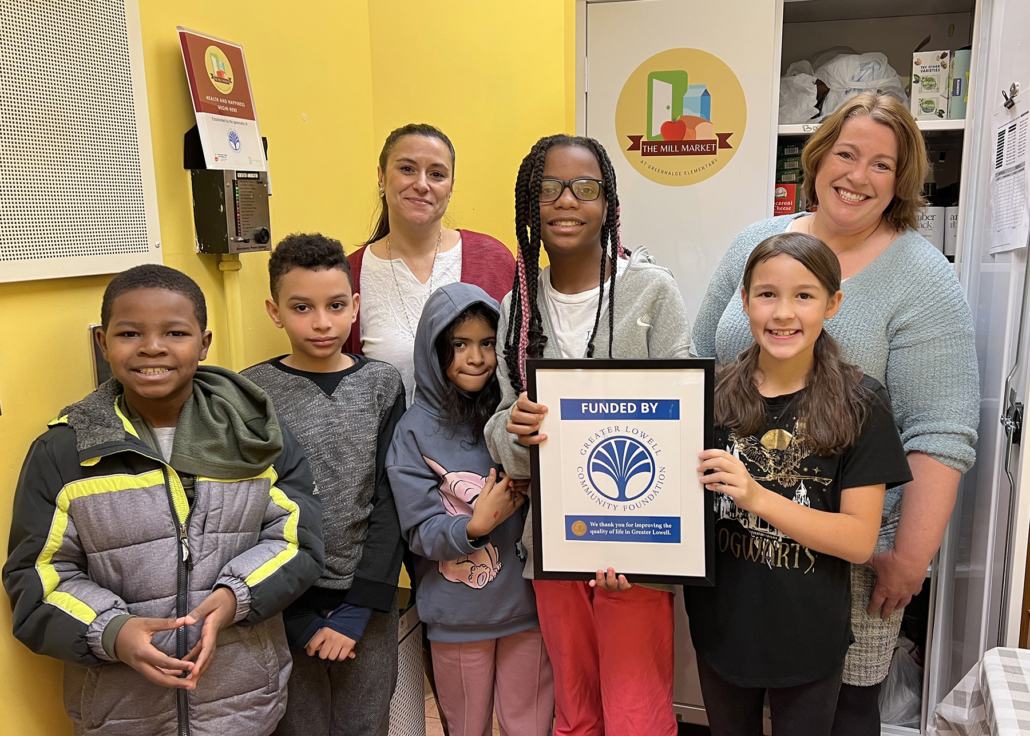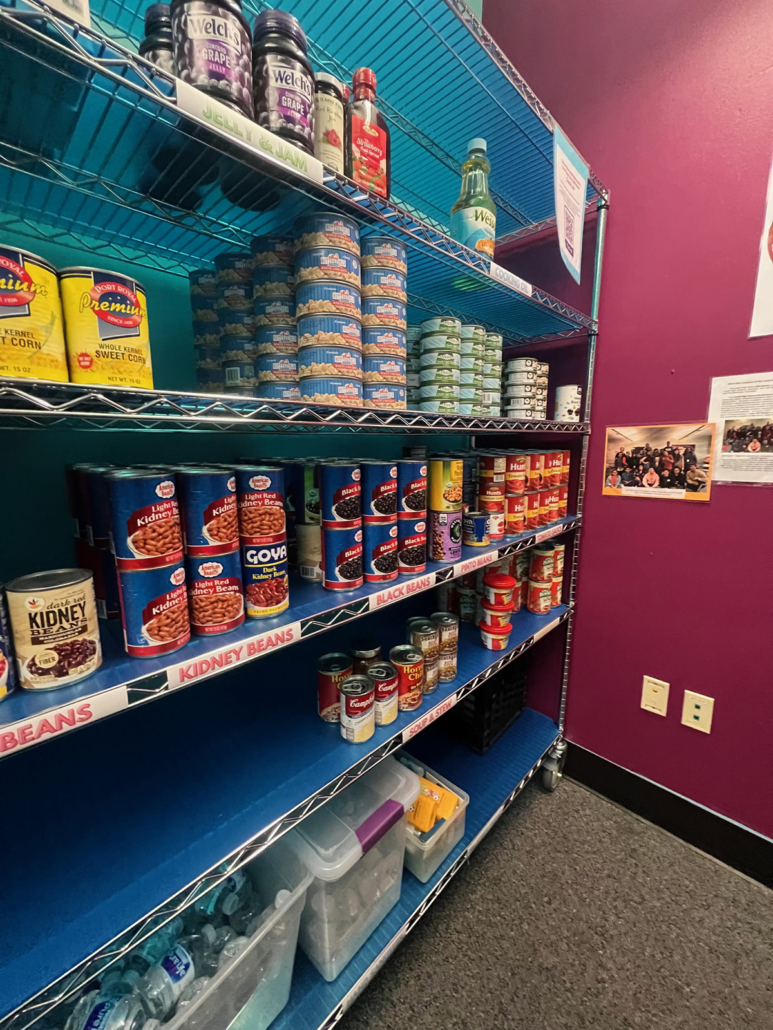Local Partners Address Youth Food Insecurity with In-School Food Pantries
by Kathy Register

Lowell, MA – Recognizing the growing issue of food insecurity among local children and youth, the Greater Lowell Community Foundation (GLCF) has partnered with Catie’s Closet and the Merrimack Valley Food Bank (MVFB) to establish five school-based food pantries, known as Mill Markets, in Lowell Public Schools.
GLCF’s Youth Food Insecurity Initiative was launched in 2021 and expanded on a pilot food pantry set up at Lowell High School in 2017 by a group of LHS students. These new, GLCF-supported Mill Markets are well-organized and stocked with culturally appropriate foods that appeal to students. They are located at Lowell High School (B House), Bartlett Community Partnership School, Freshman Academy at LHS, Frederic T. Greenhalge Elementary School, and Joseph G. Pyne Arts Magnet School.
“After conducting a regional survey about youth food insecurity, and examining the barriers that can prevent kids and teens from accessing nutritious food, the Foundation learned that a lot of need could be alleviated by establishing and maintaining in-school food pantries,” explained Jay Linnehan, GLCF President and CEO.
“So, we turned to two of our trusted local nonprofit partners — Catie’s Closet and Merrimack Valley Food Bank — to help implement our vision of bringing healthy, shelf-stable food directly to youth in their schools.”
Enlisting the assistance of MVFB and Catie’s Closet made sense, as both nonprofits are already addressing the needs of low-income students in the Lowell schools. Through Operation Nourish, Merrimack Valley Food Bank supplies food for 1,200 students a month in Greater Lowell and Lawrence. And Catie’s Closet provides clothing and toiletries to students through its in-school Closets, which are set up like retail stores, where students can “shop” for items, free of charge.
“When GLCF first approached me about establishing Mill Markets, I said, ‘Whatever you do, it needs to be in the schools,’ ” explained Mickey Cockrell, CEO and co-founder of the highly successful Catie’s Closets. “These kids have no means of transportation to visit a regular food pantry and then get the food home.
“We have based our Closets in school settings, and are located in all Lowell schools,” she added. “We want kids to run toward the school to solve these problems.”
Another suggestion Cockrell made was to make sure older students can select which food items they want to eat. “I think giving teens the agency to choose is essential,” said Cockrell, who has an extensive background in retail sales.
“That has been key to the success of Catie’s Closet: The kids get to select — and try on — the clothes they want to wear. And I imagined it would be key for youth food pantries, too.”
Armed with these suggestions, GLCF elected to add Mill Markets to already-established Catie’s Closets in the five schools, explained Jennifer Aradhya, GLCF’s Vice President of Marketing, Programs & Strategy.
“Mickey and Catie’s Closet supplied the food-storage cabinets, signage and staffing for the new Mill Markets,” said Aradhya. “And, based on the Catie’s Closet model, students can access the food pantries confidentially.”
GLCF turned to Merrimack Valley Food Bank (MVFB) to provide nonperishable food for its Mill Markets. The Foundation has also provided funding to support a part-time MVFB employee assigned to keep the pantries well stocked, according to Aradhya.
The collaboration has proved so successful that more in-school food pantries are being established, added Aradhya. In early 2023, a new Mill Market will open at Henry J. Robinson Middle School, thanks to a recently announced $25,000 GLCF grant in honor of the Foundation’s 25th Anniversary. GLCF has also contributed funding to support food pantries at Lincoln Elementary School and Leblanc Therapeutic Day School.
“Mill Markets are basically mini-food pantries,” explained Roberta Emerson, Program Director of MVFB’s Operation Nourish. “They sit right next to, or are located inside, a Catie’s Closet, so students can make one stop and get everything they need.

“For example, if a student needs a sweatshirt or deodorant, they can visit the Catie’s Closet in their school. Then a staff member might say, ‘Check out our new Mill Market over here. You might see some food you’d like to prepare for your family tonight.’ ”
“We do our best to provide familiar foods to the Mill Markets,” said Debbie Callery, MVFB’s Executive Director. “Each school gives us a list of what their students prefer. Staples like macaroni & cheese, and pasta are popular, as well as tuna, peanut butter, and shelf-stable milk – plus different varieties of dried beans and rice.
“Kids can go to Mill Markets whenever they want – and as many times as they want,” stressed Callery. “There’s no registration or application. They could be grabbing something for dinner that night or just picking up a snack. After-school snacks are especially popular with student athletes headed to practice.”
GLCF’s partnership approach aligns with the Lowell Public Schools’ Community Schools Strategy, according to Lauren Campion, Director of LPS’ Student Resource Center.
“Basically, this strategy means we are intentionally integrating community partnerships into our schools to meet the wrap-around needs of our students and their families,” she said. “These strategic partnerships support learning and the academic success of our students.”
All 28 Lowell public schools, at all grade levels, serve free breakfast and lunch, explained Campion. “Mill Market food pantries very much complement the food service we already provide through district funding,” she added.
School administrators with Mill Markets in their facilities, agree. “Having the food pantry here at school is amazing,” said Monica Melo Ernest, Community School Manager at Greenhalge Elementary School, which serves students from pre-K through 4th grade.
“According to my data, we’ve already had about 134 families access the Mill Market at some point this year. We have 62 families that consistently use it — and we’re adding families.”
Solangel Polanco, Community School Manager at Bartlett Community Partnership School (pre-K-8) is equally enthusiastic. “The location of the Mill Market here at Bartlett is within the same space as our Catie’s Closet, which works well, because students might need to visit both places.
“We are definitely seeing an increase in students receiving food. Last year, we were providing weekly bags of food to 25 elementary students (who are too young to shop for themselves). This year, we are up to 46. And the kids seem to like the food — especially the microwave-ready soups and snacks.”
MVFB is so pleased with the new Mill Markets, said Callery, that it’s hoping to expand in-school food pantries to other schools in the area.
To learn more about GLCF, visit: www.glcfoundation.org.
About Greater Lowell Community Foundation –Established in 1997, the Greater Lowell Community Foundation (GLCF) is a philanthropic organization comprised of more than 400 funds dedicated to improving the quality of life in 21 neighboring cities and towns. With financial assets of almost $60 million, GLCF annually awards grants and scholarships to hundreds of worthy nonprofits and students. It is powered by the winning combination of donor-directed giving, personal attention from Foundation staff, and an in-depth understanding of local needs. The generosity of our donors has enabled the Community Foundation to award more than $35 million to the Greater Lowell community.
###

